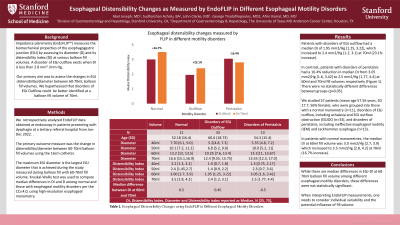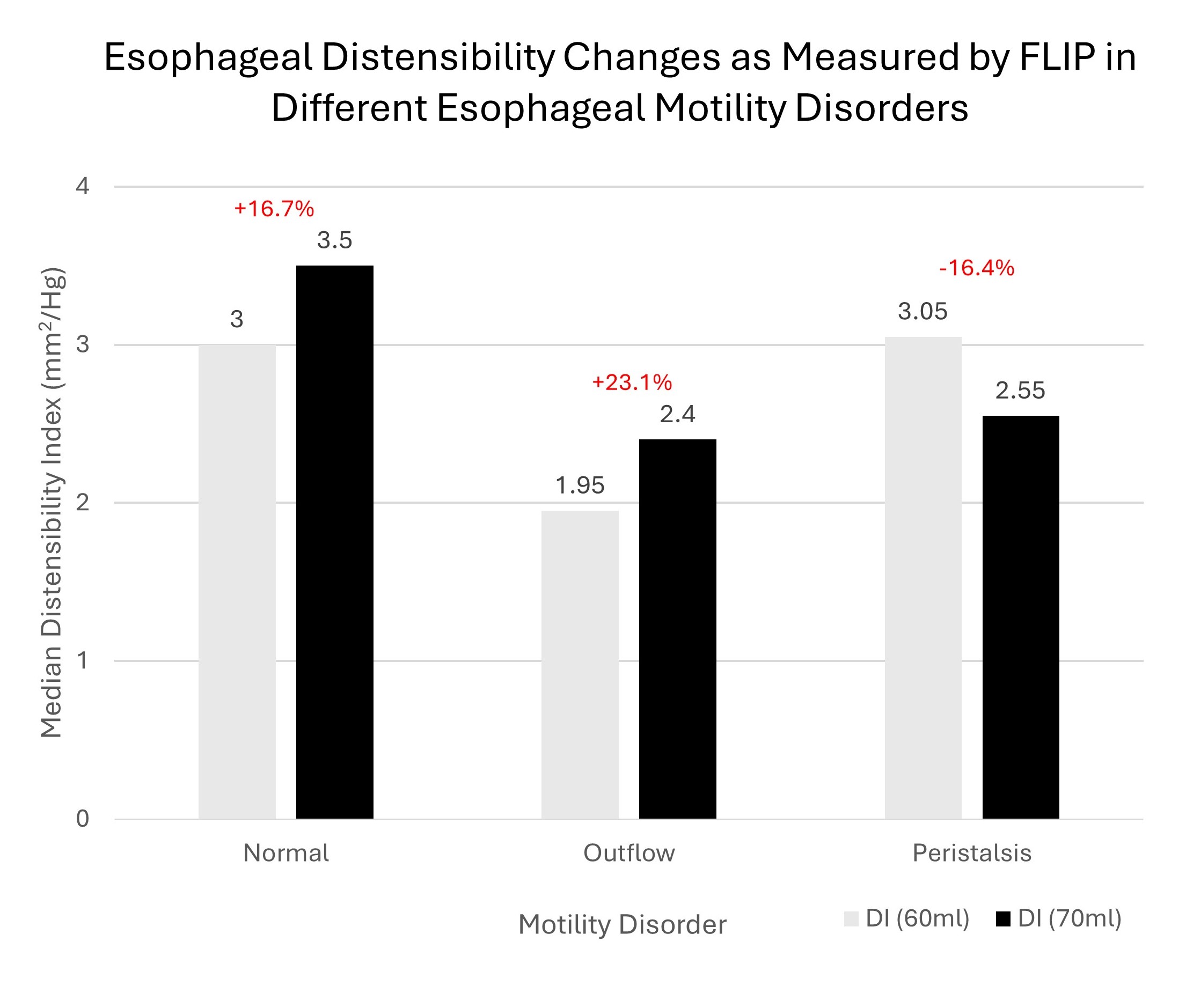Sunday Poster Session
Category: Esophagus
P0492 - Esophageal Distensibility Changes as Measured by EndoFLIP in Different Esophageal Motility Disorders
Sunday, October 27, 2024
3:30 PM - 7:00 PM ET
Location: Exhibit Hall E

Has Audio

Abel Joseph, MD
Stanford University
Palo Alto, CA
Presenting Author(s)
Abel Joseph, MD, Sudharshan Achalu, BA, George Triadafilopoulos, MD, FACG, John Clarke, MD, Afrin Kamal, MD, MS
Stanford University, Palo Alto, CA
Introduction: Impedance planimetry measures the biomechanical properties of the esophagogastric junction (EGJ) by assessing its diameter (D) and its distensibility index (DI) at various balloon fill volumes. A disorder of EGJ outflow exists when DI is less than 2.8 mm2 /mm Hg. Our primary aim was to assess the changes in EGJ distensibility/diameter between 60-70mL balloon fill volumes. We hypothesized that disorders of EGJ Outflow could be better identified at a balloon fill volume of 70ml.
Methods: We retrospectively analyzed EndoFLIP data obtained at endoscopy in patients presenting with dysphagia at a tertiary referral hospital from Jan-Dec 2022. The primary outcome measure was the change in distensibility/diameter between 60-70ml balloon fill volumes using the 16cm catheter. The maximum EGJ diameter is the largest EGJ diameter that is achieved during the study measured during balloon fill with 60-70ml fill volume. Kruskal-Wallis test was used to compare median differences in DI and D among normal and those with esophageal motility disorders per the CCv.4.0, using high-resolution esophageal manometry.
Results: We studied 57 patients (mean age 57.56 years, SD 17.7, 56% female), who were grouped into those with a normal manometry (n=11), disorders of EGJ outflow, including achalasia and EGJ outflow obstruction (EGJOO (n=33), and disorders of peristalsis, including ineffective esophageal motility (IEM) and Jackhammer esophagus (n=13). In patients with normal manometries, the median DI at 60ml fill volume was 3.0 mm2/Hg [2.7, 3.9] which increased to 3.5 mm2/Hg [2.8, 4.2] at 70ml (16.7% increase). Patients with disorders of EGJ outflow had a median DI of 1.95 mm2/Hg [1.25, 3.22], which increased to 2.4 mm2/Hg [1.2, 3.1] at 70ml (23.1% increase). In contrast, patients with disorders of peristalsis had a 16.4% reduction in median DI from 3.05 mm2/Hg [1.6, 3.42] to 2.5 mm2/Hg [1.77, 4.4] at 60ml and 70ml fill volumes respectively (Figure 1). There were no statistically different differences between groups (p >0.05).
Discussion: While there are median differences in EGJ-DI at 60-70ml balloon fill volume among different esophageal motility disorders, these differences were not statistically significant. When interpreting EndoFLIP measurements, one needs to consider individual variability and the potential influence of fill volume.

Note: The table for this abstract can be viewed in the ePoster Gallery section of the ACG 2024 ePoster Site or in The American Journal of Gastroenterology's abstract supplement issue, both of which will be available starting October 27, 2024.
Disclosures:
Abel Joseph, MD, Sudharshan Achalu, BA, George Triadafilopoulos, MD, FACG, John Clarke, MD, Afrin Kamal, MD, MS. P0492 - Esophageal Distensibility Changes as Measured by EndoFLIP in Different Esophageal Motility Disorders, ACG 2024 Annual Scientific Meeting Abstracts. Philadelphia, PA: American College of Gastroenterology.
Stanford University, Palo Alto, CA
Introduction: Impedance planimetry measures the biomechanical properties of the esophagogastric junction (EGJ) by assessing its diameter (D) and its distensibility index (DI) at various balloon fill volumes. A disorder of EGJ outflow exists when DI is less than 2.8 mm2 /mm Hg. Our primary aim was to assess the changes in EGJ distensibility/diameter between 60-70mL balloon fill volumes. We hypothesized that disorders of EGJ Outflow could be better identified at a balloon fill volume of 70ml.
Methods: We retrospectively analyzed EndoFLIP data obtained at endoscopy in patients presenting with dysphagia at a tertiary referral hospital from Jan-Dec 2022. The primary outcome measure was the change in distensibility/diameter between 60-70ml balloon fill volumes using the 16cm catheter. The maximum EGJ diameter is the largest EGJ diameter that is achieved during the study measured during balloon fill with 60-70ml fill volume. Kruskal-Wallis test was used to compare median differences in DI and D among normal and those with esophageal motility disorders per the CCv.4.0, using high-resolution esophageal manometry.
Results: We studied 57 patients (mean age 57.56 years, SD 17.7, 56% female), who were grouped into those with a normal manometry (n=11), disorders of EGJ outflow, including achalasia and EGJ outflow obstruction (EGJOO (n=33), and disorders of peristalsis, including ineffective esophageal motility (IEM) and Jackhammer esophagus (n=13). In patients with normal manometries, the median DI at 60ml fill volume was 3.0 mm2/Hg [2.7, 3.9] which increased to 3.5 mm2/Hg [2.8, 4.2] at 70ml (16.7% increase). Patients with disorders of EGJ outflow had a median DI of 1.95 mm2/Hg [1.25, 3.22], which increased to 2.4 mm2/Hg [1.2, 3.1] at 70ml (23.1% increase). In contrast, patients with disorders of peristalsis had a 16.4% reduction in median DI from 3.05 mm2/Hg [1.6, 3.42] to 2.5 mm2/Hg [1.77, 4.4] at 60ml and 70ml fill volumes respectively (Figure 1). There were no statistically different differences between groups (p >0.05).
Discussion: While there are median differences in EGJ-DI at 60-70ml balloon fill volume among different esophageal motility disorders, these differences were not statistically significant. When interpreting EndoFLIP measurements, one needs to consider individual variability and the potential influence of fill volume.

Figure: Esophageal distensibility changes as measured by EndoFLIP in different esophageal motility disorders
Note: The table for this abstract can be viewed in the ePoster Gallery section of the ACG 2024 ePoster Site or in The American Journal of Gastroenterology's abstract supplement issue, both of which will be available starting October 27, 2024.
Disclosures:
Abel Joseph indicated no relevant financial relationships.
Sudharshan Achalu indicated no relevant financial relationships.
George Triadafilopoulos indicated no relevant financial relationships.
John Clarke indicated no relevant financial relationships.
Afrin Kamal indicated no relevant financial relationships.
Abel Joseph, MD, Sudharshan Achalu, BA, George Triadafilopoulos, MD, FACG, John Clarke, MD, Afrin Kamal, MD, MS. P0492 - Esophageal Distensibility Changes as Measured by EndoFLIP in Different Esophageal Motility Disorders, ACG 2024 Annual Scientific Meeting Abstracts. Philadelphia, PA: American College of Gastroenterology.
